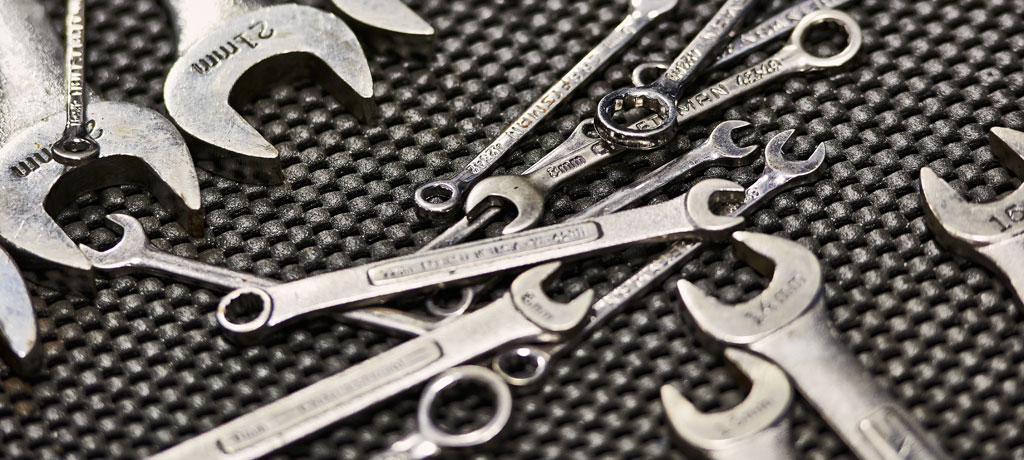
Have you ever noticed your vehicle slightly pulling to the left or the right?
If so, this is likely due to poor wheel alignment. This issue is a simple fix, yet crucial to your safety. Getting a wheel alignment also ensures a smoother ride and prolongs your tires’ lifespan.
But how do front-end alignment vs. wheel alignments differ? And how often should you get your tires aligned? In this guide, we take an in-depth look at wheel alignment—from the basics and benefits to answers to your most common questions.

Exploring Front-End Alignment vs. 4-Wheel Alignment
When learning how to align a car, you may have also heard the term “front-end alignment.” So, what’s the difference between front-end alignment vs. wheel alignment?
Let’s take a closer look at each of these services:
- Standard Wheel Alignment: Standard wheel alignments are used for most vehicles. Front wheels receive adjustments to the toe, caster, and camber, and rear wheels receive adjustments for the toe and camber.
- Front-End Wheel Alignment: These wheel alignments, also called 2-wheel alignments, are when only the front wheels are adjusted as part of the alignment. This alignment is simpler, but it’s not a service usually recommended on modern cars.
No matter the type of alignment you need, getting your wheels aligned is something every vehicle owner should routinely invest in.
How to Align a Car
While learning how to align a car can help you better understand the services performed on your vehicle, wheel alignments are typically not recommended for DIY services.
The alignment process typically involves using specialized equipment to measure the precise angles of the wheels and make adjustments as needed. Additionally, wheel alignments require vehicles to be lifted for easier access, requiring equipment most drivers don’t have access to.
Why Car Wheel Alignment Matters
Now that you understand front-end alignment vs. wheel alignment, knowing why it matters is essential. Car wheel alignment is vital to vehicle maintenance and safe driving.
When your car’s wheels are aligned correctly, they point in the right direction, providing optimal performance, stability, and handling. On the other hand, when your car’s wheels are misaligned, it causes significant problems such as uneven tire wear, steering problems, vibrations, and a decreased ability to handle the vehicle.
When your car is first manufactured, the wheels are aligned, tested, adjusted, and ultimately verified at the factory. There shouldn’t be any problem with wheel alignment in a brand-new vehicle. But over time, wheels fall out of alignment and an adjustment is necessary.
Causes of a Bad Tire Alignment
There are various reasons for wheels to fall out of alignment, including:
- Driving over potholes
- Motor vehicle accidents
- Wear and tear on shocks and struts
- Vehicle modifications
- Hitting road debris, wildlife, or curbs
- Consistently driving on rough roads
Car Misalignment Symptoms
Wheel alignment issues may not be noticeable initially, but misalignment can still cause real damage.
When tires are even slightly out of alignment, it accelerates uneven wear and tear on your tires. This means your tires won’t be performing as well as they should be, and you might have to spend money to have those tires replaced sooner than expected.
There are no warning lights or indicators for vehicle alignment issues, so regular inspections are the best way to prevent premature tears. What you might be able to notice, though, is a change in your car’s handling—such as the vehicle pulling to the left or right.
Other symptoms may include a vibrating steering wheel, or noticing it is off-center even when driving straight. Any of these indicators should send you straight to a Meineke technician for an alignment check.

Benefits of Car Wheel Alignment
A tire alignment helps your vehicle in many ways, but ultimately it ensures optimal drivability. Not only does it extend the life of your tires, but it also helps your car drive smoother and consume less energy (which usually translates into fuel savings).
Here are some of the best benefits of having your wheels aligned regularly:
- Extends the lifespan of your tires
- Smoother driving experience
- Greater fuel efficiency
- Better vehicle handling and safety
Unfortunately, there is no definite way to tell when your tires are out of alignment until you take your vehicle to an auto care professional. If too much time passes and the misalignment becomes so bad that the car no longer drives in a straight line, considerable tire damage has already been done.
It’s best to have your vehicle inspected regularly and make sure alignments are a part of your routine maintenance efforts. To learn more about front-end alignment vs. wheel alignment or get your vehicle inspected or serviced, visit your local Meineke.
Wheel Alignment FAQs:
How much does it cost to get an alignment?
Our wheel alignment services are very affordable, costing anywhere between $50 and $100—although most of the time, a tire rotation is needed as well which adds to the cost.
How do you know if you need a wheel alignment?
It is important to have regular wheel alignment checks, as there are no clear signs of misalignment until significant damage has already occurred.
Is wheel alignment a necessary service?
Although it may not seem like an important issue, driving with misaligned wheels or tires for extended periods of time will lead to more extensive damage. This will ultimately cost you more, and keep your car off the road longer.
How often should you get tires aligned?
The basic recommendation is either annually, or with every oil change. If your usual driving conditions are poor, opt for the latter. This is generally the case regardless of the type of vehicle you drive, how often you drive, and your specific driving habits.
How long does an alignment take?
Wheel alignment is a quick and straightforward service, and it takes an average of about 1 hour. If supplemental work is needed (depending on the wear and tear) then additional time may be required.





